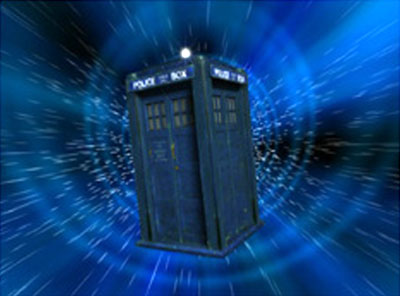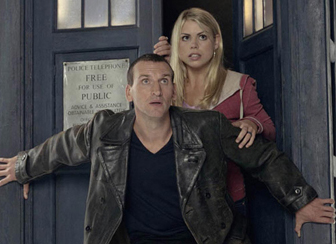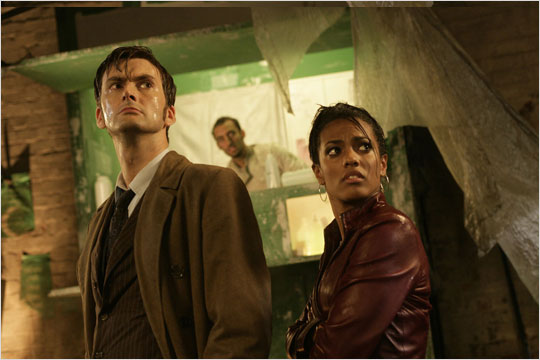After going off the air in 1989, Dr. Who suffered from indifference and derision from the high-ups within the halls of the BBC, even though the show was a “tentpole” franchise for the corporation through foreign sales of the show, videos, DVD, books and other merchandising.
Many thought that with a lot of big budget American sci-fi shows reaching the UK, Dr. Who couldn’t stand up to the high production values set by its competitors, though this was completely missing the point as regards the show’s success and longevity.
The 1996 Dr. Who TV movie produced by FOX TV and filmed in Canada, with Paul McGann as the in-continuity eighth Doctor, tried to address these concerns but in doing so lost a lot of what made Who, well, Who, really!
During the wilderness years for The Doctor, new novels following the untold adventures of the Time Lord surfaced as did independently produced licensed audio adventures starring many of actors who’d played the character in the past as well as other actors associated with the programme. However, it wasn’t until 2003, after years of rumours and a few false starts that it was announced that Dr. Who would wing his way again on to the BBC and in his old stomping ground of Saturday tea time after the sports programme Grandstand.
Acclaimed writer/producer (and hardcore Whovian) Russell T. Davis was given the go-ahead to launch the Doctor in 13 new adventures of around 45 minutes in length at the cost of one million pounds an episode, the most expensive weekly TV series ever produced by the BBC!
The Doctor will be accompanied by a companion called Rose Tyler who has more in common with the heroines of the Buffyverse than the screaming damsels in distress of yesterday.
But who is the Doctor?
The ninth Doctor will be played by 40 year-old Manchester-born Christopher Eccleston, the star of Russel T. Davis’s recent mini-series The Second Coming in which Eccleston played Christ, who was born again in modern day Manchester. Eccleston won plaudits for his role in the BBC drama Our Friends in the North, while U.S. citizens might recognise him from the film Gone in 60 Seconds, where he played the bad guy.
Written by Peter Noble

Doctor # 9: Christopher Eccleston

After the 1996 movie, which starred Paul McGann, it was pretty much back to the drawing board for the various production companies out there that wanted to do a Doctor Who series. Much was in discussion at various levels. There were plans underway for another movie, and there was even one production company that was looking to do a new Doctor Who show with Tom Baker, only with a slightly different spin. Veteran Doctor Who guest actor Michael Sheard, who is best known for having played many roles on Doctor Who throughout nearly every era, was even approached at one point to play The Doctor. Nothing, however, was really happening, other than a lot of talk, a lot of rumour, and much speculation.
Speculation and rumour reached a fever pitch in the winter of 2003 when the BBC announced that they would be bringing Doctor Who back for Saturday Evening Prime Time Viewing. It’s appropriate that the announcement of The Doctor’s return was given on the same year that Doctor Who was celebrating its 40th anniversary.
So the hunt was on for the ninth Doctor. Several actors were considered, including comedian turned actor Eddie Izzard. Bill Nighy was also rumoured to be in the running for the role, as was Richard E. Grant. The part ultimately went to actor Christopher Eccleston, who would take control of the TARDIS and would be assisted by Billie Piper as his streetwise assistant, Rose Tyler.
It is interesting to note that at no point during Christopher Eccleston’s run as The Doctor do we see Paul McGann regenerate into Eccleston’s Doctor. This is historic as it marks only the second time in the show’s history where we have not seen the Doctor regenerate into his new incarnation: Patrick Troughton, the second Doctor, never regenerated on screen when he passed the baton to Jon Pertwee.
Eccleston also makes history for being the shortest serving actor to take on the role of The Doctor (in a regular series). After the first episode “Rose” premiered on BBC1 on the 28th of March 2005, Eccleston told the newspapers that he would be stepping down as The Doctor once he had completed the 13 episode run. But what a run Eccleston’s Doctor would enjoy.
During the Tom Baker era of Doctor Who, the BBC saw ratings of 17 million viewers at the show’s peak. Of course this would not be possible today given that the market for British Terrestrial Television (Broadcast Television) now has to contend with cable and satellite stations as well as its main Terrestrial rival, ITV1, which up until Doctor Who’s premiere was getting higher ratings. But the reintroduction of Doctor Who into the BBC’s early Saturday evening schedule was a revelation and the series managed a whopping 10 million Viewers during its first week. Of course in subsequent weeks the ratings dropped off a bit to about 8 million, but in the present day Market of British Television 8 million is more than enough to justify keeping a show on the air.
During his short tenure as The Doctor, Eccleston would re-introduce fans to the wonders that are out there in time and space. The first episode “Rose” brought The Doctor head-to-head with the Autons and the Nestene Consciousness. This would be the third time that The Doctor had done battle with the Autons, the first two times were during Jon Pertwee’s era in the episodes “Spherehead from Space” and “Terror of the Autons”.
In the second episode of Eccleston’s run we learn that The Doctor is the last of the Time Lords. It would later be revealed in the episode “Dalek” that The Doctor’s home world, Gallifrey, and all its inhabitants (except for The Doctor, himself) were wiped out during the time war with the Daleks.
Although Eccleston’s run was short, it is fair to say that his interpretation of The Doctor went a long way toward re–introducing the Doctor to the existing fan base and garnering new fans. There were a few changes to Eccleston’s Doctor: gone was the fancy dress which had dogged Peter Davison, Colin Baker and Sylvester McCoy’s eras. The new Doctor sported clothes that were more indicative of the 21st century. Also The Doctor also sported a northern accent in the new series, which became something of a running joke. The decision to have Eccleston speak in his regional accent was a mutual one between him and producer Russell T. Davies. Eccleston felt that modern television viewers would view the prior incarnation’s use of ‘Received Pronunciation,’ which is an acting term for speaking in a posh manner without using an accent, as too elitist. This was a decision that worked well for Eccleston’s interpretation of the role, which was helped along by the classic quote “Lots of planets have a north.”
Eccleston’s run as the Doctor ended with the final episode of this series; damaged by the stresses of his fight with the Daleks and saving Rose from the raw power of the TARDIS, as a weak and baffled Rose looked on, Eccleston’s Doctor regenerated into the tenth actor to portray this icon of science fiction, David Tennant.
– written by Ian M. Cullen
Doctor # 10: David Tennant

After having had a particularly stressful fight with the Daleks and having to save Rose from being consumed by the power from his TARDIS, The Doctor (Christopher Eccleston) is forced into taking the power from Rose and reinserting it into the TARDIS. The stress from the task forces the ninth Doctor into regenerating his whole body that leaves his assistant and friend Rose somewhat shocked at the Doctor’s new appearance.
When we are introduced to David Tennant as the tenth Doctor, he is initially a little shaken-up and emotionally erratic from the stress of regenerating. In fact he is so stressed that we see very little of him in his first story which was “The Christmas Invasion”, though by the end of the episode thanks to a timely pot of traditional English tea, our heroic Time Lord is able to step out from the TARDIS in a memorable scene quoting from the Lion King while fighting against the Sycorax threat. In the fight he loses his hand but regenerates a new one. “No second chances, that’s the kind of man I am”, he says just after killing the Sycorax leader with a clementine.
This new Doctor is lighter in tone but retains a veiled darker side when pushed too far, which shows up in several episodes. We also get to see a more human side to the tenth Doctor who isn’t afraid to talk about his personal loneliness. In the episode School Reunion he shows us a vulnerable side when he talks about the fact that he will outlive all his assistants.
Where Christopher Eccleston’s doctor reintroduced long-time and new fans to the Daleks, this Doctor introduced new fans to the Cybermen. These Cybermen were a newer breed, which allowed the writer to do a whole new origin story that is set on a parallel Earth.
Where all other incarnations of the Doctor often faced personal danger against the Daleks, David Tennant’s Doctor had the dubious honour of facing off against both the Daleks and Cybermen in the two-part finale of Series Two, “Army Of Ghosts” and “Doomsday.” In these episodes, the Doctor suffers a great loss when he has to send his companion Rose to the parallel Earth in order to insure her safety. This also marks the end of the audience’s long-standing relationship with Rose’s extended family of her mum, Jacquie, and long-suffering boyfriend, Mickey.
However, as with everything in life, the more things change the more they stay the same, and The Doctor’s hunger for adventure continues on. After a brief adventure with a runaway bride and a very dark and sinister confrontation with the Racnoss, he continues on to meet doctor-in-training Martha Jones, who, unlike Rose, is able to match The Doctor in intelligence.
The Doctor’s first adventure with Martha sees him posing as ‘John Smith’ a name that was introduced into Doctor Who canon during the Jon Pertwee era of the programme.
The Doctor and Martha first meet in a hospital, which suddenly finds itself transported to the moon. The plot thickens when we meet the Judoon, a rhino-like race who are hunting a kind of space vampire. After having helped him, The Doctor offers Martha one adventure with him, but it soon becomes apparent after more than a few dangerous situations that Martha is an asset to The Doctor.
Martha gets to prove how invaluable she is to The Doctor when he has to use the TARDIS to alter his genetic make-up to trick an alien family that are after his Time Lord DNA. In the episode “Human Nature,” Martha is tasked with playing caretaker to The Doctor’s Time Lord essence, which is stored in an old-fashioned Victorian fob watch. The Doctor, who is ignorant of his existence as an intergalactic time traveller, assumes the identity of schoolmaster John Smith, who teaches in a 1913 private school. After some time his ruse is blown and he eventually is forced into giving up his artificially induced humanity, changing back to his true self in order to bring the family to justice. We get to see The Doctor’s darker side in this story, and soon learn that by hiding he was trying to be kind to the Family Of Blood.
Throughout this season we see an unrequited love story unfold, as Martha comes to realise that The Doctor will never see her in a romantic light, despite all her subtle ministrations. It’s only after aiding The Doctor in their fight against his Time Lord rival – the newly revived Master, that she finally comes to realise he will never see her as anything more than a great friend and thus she chooses to depart the TARDIS but asks the Doctor to keep in touch anytime he passes by.
At this writing, Series Three (Tennant’s second as The Doctor) has been completed. On 25 December, 2007, a special entitled “Voyage of the Damned” aired on BBC1. Tennant is slated to continue as The Doctor for Series Four in 2008.
Stay tuned to this section for the continuing adventures of David Tennant’s 10th Doctor.
Written by Ian M. Cullen